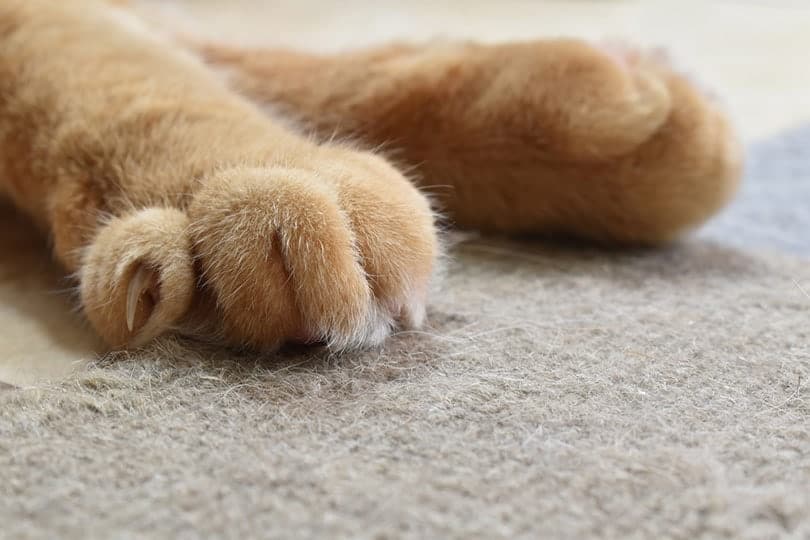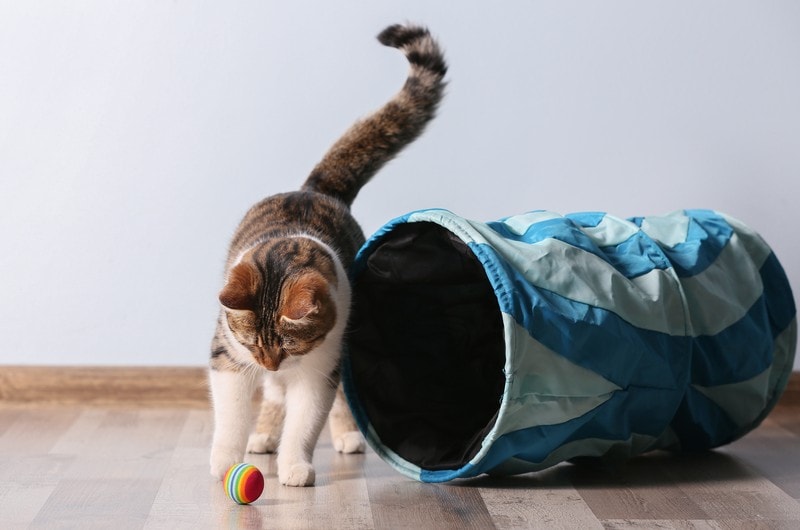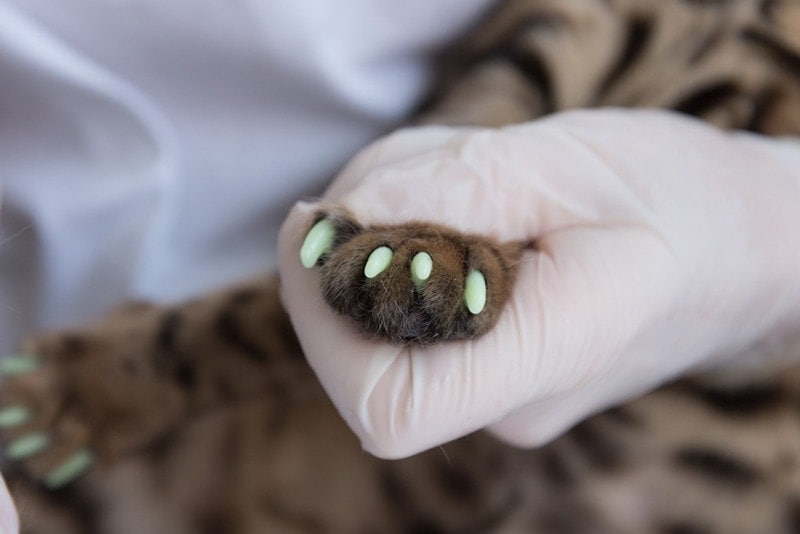Click to Skip Ahead
When you’re a cat, scratching comes with the territory, but if it occurs on your carpet, it can cause significant damage. Protecting your carpet from cats isn’t difficult, and you can use several techniques.
The best approaches combine several methods so that you can protect your carpet and retrain your cat to scratch someplace less damaging. Here are 10 methods that you can use to protect your carpet from your cat’s claws.

The 4 Ways to Cover Your Carpet
The first solution to your cat scratching your carpet is to protect your carpet by covering it. Here are four ways you can cover your carpet and keep cats away.
1. Use Plastic Carpet Runners
A plastic carpet runner is one of the best products to cover your carpet. The runners are made of clear vinyl or plastic and might have ridges on the bottom to grip the carpet. They protect carpets in high-traffic areas and won’t them.
You can also buy similar plastic guards to go under rolling chairs in office spaces. A plastic carpet runner will protect your carpet for as long as you need to help your cat find better scratching spots.
2. Stick on Double-Sided Tape
If you only need a small spot protected, double-sided tape can make an effective deterrent for cats. Putting stripes of tape every few inches apart will make the area unpleasant to scratch and keep cats away.
The sticky tape is annoying to touch for cats and doesn’t work well for scratching. This method works best when it’s temporary. In the long term, the plastic tape can become annoying and require frequent reapplication.

3. Cover Common Scratch Spots
If there’s one spot your cats like to scratch, consider covering it up. Whether you use a rug, sheets of tinfoil, or a piece of furniture, removing access to the scratching area might persuade your cat to choose a more appropriate spot.
Covering a spot for a few weeks is long enough for the scent to fade and make your cat forget about the scratching spot.
4. Use a Scent-Based Deterrent
Instead of physically covering up your carpet, you can use a deterrent to stop your cat from scratching in unwanted areas. These deterrents usually include a substance that smells bad to cats but is pleasant or not noticeable to humans. You can buy a commercially formulated deterrent to keep your cat away from a scratching spot or use a homemade one.
One of the most common homemade deterrents is spraying diluted citrus oil over the area. This is an effective solution, but it requires caution since undiluted essential oils can harm cats.

The 4 Ways to Redirect the Behavior
Cats have an innate need to sharpen their claws by scratching, and it’s important to keep your cats’ claws healthy. When dealing with a destructive cat, you need to redirect the behavior to appropriate outlets, not remove it entirely.
1. Change Up Your Scratching Posts
If your cat has a scratching post that goes unused or has fallen out of favor, a replacement might be necessary. Carpet-scratching cats often prefer horizontal scratchers or a mix of horizontal and vertical scratchers.
You can use various materials like sisal, carpet, and cardboard and place the scratching posts in areas your cat uses frequently. Scratching posts should be sturdy and stable, or your cat may become afraid to use them.
2. Encourage Positive Behavior
As you try to get your cat to use scratching posts instead of carpet or furniture, positive reinforcement will help more than punishment. You can use catnip around scratching posts or treat your cat when you notice them scratching on the scratcher.
When you see your cat scratching the carpet, you can calmly redirect them by sliding the scratching post over to them. Calm, consistent redirection is more effective than shouting or punishment when reducing bad behavior.
3. Reduce Stressors
If your cat seems to be acting up on purpose or scratching excessively, they might be stressed. The stressors can include health issues, conflict with other pets, conflict or shouting in the home, new people or animals in the household, and the lack of a daily routine.
Some of the stress your cat experiences will decrease when they get used to a new person or routine, but you can also help by identifying what irritates your cat. Reducing the stress in your cat’s life will limit misbehavior and help them return to their normal rate of scratching.
4. Keep Your Cat Busy
Boredom is a major cause of excessive scratching. Your cat should have several toys that allow for different kinds of play. You can provide interactive toys that allow your cat to play when no one is around to entertain them.
However, they should also have social stimulation. Putting aside time daily to play with your cat is great exercise and will help them feel loved and secure. Other types of social behavior, such as brushing your cat or sitting with them, can also decrease boredom and loneliness.

The 2 Ways to Dull Your Cat’s Claws
You can also prevent your cat from damaging the carpet, by trimming or covering their claws. Declawing cats causes permanent damage to their feed and can lead to lasting pain or health complications, but there are other ways to stop cats’ claws from damaging the carpet.
1. Trim Claws Regularly
One solution is to trim your cat’s claws regularly. Claw trimmers take off the sharp tip of the nail without cutting into the quick, making them painless and safe for cats. Depending on your carpet and how smooth your cat’s nails are after trimming, trimmed nails might still be able to cause damage to your carpet.
2. Use Vinyl Claw Covers
An alternative is to buy vinyl claw covers. These covers act as soft shields that prevent your cat from causing damage. They are usually glued onto your cat’s claws and require replacing every few months. Claw covers are safe for your cat and don’t cause pain or damage.
Because they remove one of your cat’s natural defenses, they shouldn’t be used on cats that spend unsupervised time outdoors. With vinyl claw covers, no amount of scratching will damage your carpet or furniture.

Last Thoughts
As you can see, there’s a lot more to protecting your carpets than you might think! None of these methods are foolproof by themselves, but when combined, you can use them to create a plan to keep your cats healthy and happy and your carpet safe.
See also:
- 5 Best Nail Caps for Cats – Reviews & Top Picks
- 10 Best Cat Repellent Sprays for Furniture – Reviews & Top Picks
Featured Image Credit: big dipper, Shutterstock













